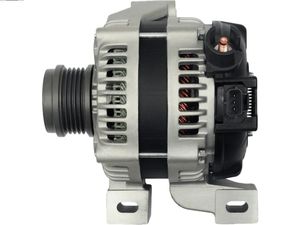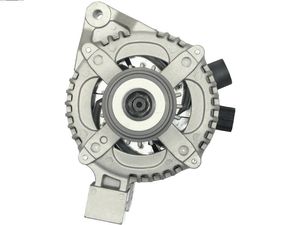(4894 products available)















































































































































































The 150A alternator generates 150 amps of electrical current, making it ideal for heavy-duty applications. It is particularly suitable for vehicles with numerous electronic accessories, such as audio installations, GPS, and lighting. There are several kinds of 150A alternators, including the following:
Other types of 150A alternators include the following:
Below are some of the specifications of the 150a alternator:
Rated Output
The 150-amp alternator has a steady output of 150 amps. Some of the alternators are rated higher, but they have a lower amp output. This means that the alternator can charge a larger deep cycle battery and run a bigger power system.
Voltage Output
The voltage output of a 150 amp alternator ranges between 12 to 16 volts. The voltage output is constant, meaning users can rely on the voltage without fluctuations.
Physical Dimensions
The physical dimensions of a 150 amp alternator vary depending on the manufacturer. Generally, the alternator has a length of 10.6 inches, a width of 10.2 inches, and a height of 5.5 inches. It also has a weight of 14 lbs.
Mounting Options
The alternator has several mounting options. This includes a rear or front mount. Having alternative mounting options allows the alternator to be mounted in various locations.
Cooling System
150 amp alternators are available in two cooling systems, which are air and liquid cooling. The cooling system used in the alternator impacts the performance level.
Rotation Direction
The alternator has a clockwise and counterclockwise rotation. The rotation direction of the alternator is determined by the motor it is connected to.
Terminal Configuration
Terminal configuration is the electrical connections of the alternator. The 150a alternator has a stud and a blade terminal configuration.
Regulator Type
The alternator has an internal voltage regulator. The regulator controls the voltage output of the alternator, ensuring it remains constant.
Here are some maintenance tips for the 150a alternator.
Regular Inspection
Carry out regular physical inspection. This will ensure that loose bolts, worn-out belts, or damaged components are detected and fixed. Also, inspect the electrical connections to ensure that there are no corroded or damaged connections. Make sure that the connections are secure.
Keep It Clean
Ensure that the alternator is free from dirt and dust. This can be done by wiping it regularly with a clean cloth. Also, keep the area around the alternator clean. This will prevent debris from entering the alternator.
Check The Belt
Inspect the belt used to drive the alternator. Ensure that the belt has the correct tension and is not loose or worn out. A loose belt can reduce the performance of the alternator.
Monitor Voltage Output
Use a multimeter to check the voltage output of the alternator. The voltage output should not be less than 12 volts or more than 14.5 volts. If the voltage output is above or below this range, it indicates that the alternator is faulty.
Replace Worn Parts
After regular inspection, worn-out or damaged parts should be replaced immediately. This will prevent further damage to the alternator.
Professional Servicing
Once in a while, take the alternator to a professional for servicing. The professional will carry out a detailed inspection of the alternator.
Wholesalers should consider these factors when selecting the right 150A alternator for their target market.
Vehicle compatibility
Some vehicles are more demanding than others when it comes to the electrical system. The power requirements for luxury cars with a lot of electronic accessories (like seat heaters, a bigger display, and more) should be considered. Even if the alternator can be installed in the vehicle, it is important to ensure that the 150A alternator is suitable for the vehicle.
Future upgrades
If there are plans to install more accessories that require power in the future, it is a good idea to go for the 150A alternator. This will ensure that there is enough power to run everything smoothly. Also, consider getting a heavy-duty battery that can handle the extra power from the alternator.
Quality and warranty
Look for a 150A alternator from a reputable manufacturer. Such alternators are known for their quality and durability. Check the warranty period to ensure that it is covered for a reasonable time in case of any defects. Problems with the alternator can be costly, so it is worth investing in a high-quality product.
Noise and cooling considerations
Some alternators are noisier than others. If a quiet operation is important, look for an alternator that has been designed to run smoothly and quietly. Also, consider how the alternator cools itself. Some have built-in fans, while others rely on airflow from around the engine bay. If driving in hot weather or stop-and-go traffic, a fan may be helpful to keep the alternator cool.
Custom installation
Some vehicles may require additional components (like brackets or pulleys) to install a 150A alternator properly. It is important to find out if this is needed and to purchase them before attempting to install the alternator. The manufacturer's website should have information about installing the alternator in different vehicles. This will help determine if extra parts are needed for the specific vehicle.
It is advisable to get a professional to replace a 150-amp alternator. However, it is possible to replace the alternator as a DIY project. Here are the steps to follow:
First, it is important to read the manufacturer's instructions for the specific vehicle make and model. Different vehicles have different methods of alternator replacement.
Q1: Can a 150A alternator be used on smaller vehicles?
A1: Yes, the alternator can be used in smaller vehicles. However, it is crucial to consider the compatibility of the 150A alternator with the vehicle's electrical system and engine bay space.
Q2: What is the lifespan of a 150A alternator?
A2: The lifespan of a 150A alternator varies depending on factors such as usage, maintenance, and operating conditions. Generally, it lasts between 7 to 10 years. However, with regular maintenance and timely replacement of worn-out parts, the alternator can last longer.
Q3: Does a 150A alternator require special maintenance?
A3: A 150A alternator does not require special maintenance. However, it needs regular maintenance like any other alternator. The maintenance involves periodic inspection, cleaning, and ensuring proper connections.